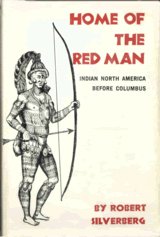Home of the Red Man: Indian North America before Columbus
- Form
- Non-fiction
- Year
- 1963
Publication history
- 1963: Home of the Red Man: Indian North America before Columbus, New York Graphic Society Hard cover book, 252 pp.
- 1971: Home of the Red Man: Indian North American Before Columbus, Washington Square Mass market paperback
Blurb
(From New York Graphic Society 1963)HOME OF
THE RED MAN
Indian North America
Before Columbus
by ROBERT SILVERBERG
Illustrations by Judith Ann Lawrence
Maps by Rafael Palacios
We all know that 1492 is the correct date of Columbus's discovery of America. But actually it had been discovered thosands of years before by the people we call American Indians. By 1492 they occupied North America from the Pacific to the Atlantic, from the Great Lakes to the Gulf of Mexico.
Who were they? Where did they come from? What did they look like? How did they live? What language did they speak?
These are only some of the questions answered in this book about these endlessly interesting first Americans. Some of the facts are: the original inhabitants almost certainly came from Asia; over 600 languages were spoken by about three million people; there were no horses at all until the Spanish brought them. And of course, the people were not "Indians" at all! Columbus was so sure that he had found a route to the Orient that he named the inhabitants of the new land incorrectly but firmly.
Their existence in America before white men came is sure to interest everyone who enjoys archaeology, history and a good mystery.
ROBERT SILVERBERG is the author of many books for young people about the worlds of the past, including LOST CITIES AND VANISHED CIVILIZATIONS and SUNKEN HISTORY. He sold his first manuscript when a college sophpmore, and has been a full-time writer since his graduation from Columbia in 1956. A lifelong New Yorker, he now lives in Riverdale in a house which was formerly the home of Fiorello La Guardia.
Comments
This was the first of several books Silverberg wrote on the subject of Native American history and culture. See also The Mound Builders and The Old Ones.
Of course, today, no one would come up with a book about the red man
, and even the term Indian
is used with caution. The dust jacket blurb deals with the second term, and Chapter 1 further explains: Indians they have remained, and no one can alter that now.
And as to the first name (or rather description): The people we must call Indians come in many colors, but never red.
To sum up...
Indians, though not from India. And
red men,although not red. Such has been the fate of these people who lived in such splendid isolation for so long—their homeland taken from them, their very names inaccurate.
Considering the time when this book was written, I think it notable that Silverberg avoids both the condescending attitude of the culturally superior
and the fallacy of the noble savage
, but presents the various tribes and nations as fully human, with virutes and faults like any of us. In spite of the un-PC title, many American school children might be better served by this book than their history textbooks.
And, of course, there is his masterful touch with the English language. I particularly like this passage from the end of Chapter 1:
A great deal of time and effort has gone into studying these fascinating Indians—though not nearly so much energy as the early Americans put into destroying them. On that starlit night in 1492, the million widely scattered Indians of North America, and the many millions south of the Rio Grande, could have had no inkling of the tragedy about to descend on them.
After 1492...there was no stopping the inexorable conquest. A land of buffalo and cougar, of grizzly and wildcat, of pueblo and tipi, began to fill up with white men who moved slowly but determinedly toward the Pacific. The forests fell. The wild life gave way. And the people we call the Indians yielded, not without stubborn and bloody resistance, until ultimately they became prisoners of war in their own country.
It is too late to mourn for past crimes. The domain of the red man has been taken over by the conquerors, and cities and freeways sprout in the old hunting grounds.
While some of the information in Chapter 2, which deals with the earliest prehistory of the continent, has been superceded by recent archaeological and DNA research, much of this book stands up well today.
Other resources
(None on file)
